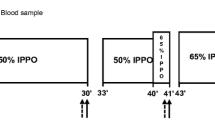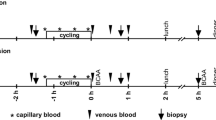Summary
The present study was conducted to investigate the metabolic regulation of the oxidation of branched-chain amino acids (BCAA) by exercise in human skeletal muscle. Five trained male volunteers were exercised on a cycle ergometer at 70%±10% (mean±SD) of their maximal oxygen consumption\((\dot V_{O_{2max} } )\). Percutaneous quadriceps muscle biopsies were obtained under local anaesthesia at rest and after 30 and 120 min of exercise. In the muscle samples the active and total amount of the branched-chain 2-oxo acid dehydrogenase complex (BC-complex), the regulatory enzyme in the oxidative pathway of the BCAA, were measured. Glycogen content and activity of mitochondrial marker enzymes were also measured. Blood samples were obtained every 20 min for the measurement of metabolites. Heart rate and rated perceived exertion on the Borg scale were recorded every 10 min. At rest 4.0%±2.5% of the BC complex was active, after 30 min of exercise 9.9%±9.0% and after 120 min 17.5%±8.5% (mean±SD). Exercise did not change the total activity. The largest activation was seen in two of the subjects who developed higher blood lactates early on during exercise and decreased their muscle glycogen more (indications of anaerobic metabolism). These data demonstrate that in trained individuals significant increases in the activity of the BC-complex occur only after prolonged intense exercise. In spite of the 4-fold activation, the data support the classical view that amino acids and protein do not contribute substantially as an energy source during exercise, since\(\dot V_{O_2 } \) increased more than 20-fold.
Similar content being viewed by others
References
Ahlborg G, Felig P, Hagenfeldt L, Hendler R, Wahren J (1974) Substrate turnover during prolonged exercise in man. J Clin Invest 53:1080–1090
Åstrand P-O, Rodahl K (1977) Textbook of work physiology. McGraw-Hill, New York
Babij P, Matthews SM, Rennie MJ (1983) Changes in blood ammonia, lactate and amino acids in relation to workload during bicycle ergometer exercise in man. Eur J Appl Physiol 50:405–411
Bergmeyer HU (1974) Methods of enzymatic analysis, 2nd edn. Academic Press, New York
Bergstrom J, Fürst P, Hültman E (1985) Free amino acids in muscle tissue and plasma during exercise in man. Clin Physiol 5:155–160
Borg G (1974) Psychological aspects of physical activities. In: Larsen LA (ed) Fitness, health and work capacity. Macmillan, New York, p 141
Calles-Escandon J, Cunningham JJ, Snyder P, Jacob R, Huszar G, Loke J, Felig P (1984) Influence of exercise on urea, creatinine, and 3-methylhistidine excretion in normal human subjects. Am J Physiol 246:E334-E338
Decombaz J, Reinhardt P, Anantharaman K, von Glutz G, Poortmans JR (1979) Biochemical changes in a 100-km run: free amino acids, urea and creatinine. Eur J Appl Physiol 41:61–72
Dietrichson P, Coakley J, Smith PEM, Griffiths RD, Helliwell TR, Edwards RHT (1987) Conchotome and needle percutaneous biopsy of skeletal muscle. J Neurol Neurosurg Psychiatry 50:1461–1467
Dohm GL, Puente FR, Smith CP, Edge E (1978) Changes in tissue protein levels as a result of endurance exercise. Life Sci 23:845–850
Dohm GL, Williams R, Kasperek GJ, Van Rij AM (1982) Increased excretion of urea and 3-methylhistidine by rats and humans after a bout of exercise. J Appl Physiol Respir Environ Exerc Physiol 52:27–33
Edwards RHT, Jones DA, Maunder C, Batra GJ (1975) Needle biopsy for muscle chemistry. Lancet I:736–740
Felig P (1981) Inter-organ amino acid exchange. In: Waterlow JC, Stephen JHL (eds) Nitrogen metabolism in man. Applied Science, London, pp 45–61
Felig P, Wahren J (1975) Fuel homeostasis in exercise. N Engl J Med 20:1078–1084
Fick A, Wislicenus J (1866) On the origin of muscular power. Philos Mag 31:485–503
Fielding RA, Evans WJ, Hughes VA, Moldawer LL, Bistrian BR (1986) The effects of high intensity exercise on muscle and plasma levels of alpha-ketoisocaproic acid. Eur J Appl Physiol 55:482–485
Goldberg AL, Chang TW (1978) Regulation and significance of amino acid metabolism in skeletal muscle. Fed Proc 37:2301–2307
Gollnick PD (1986) Adaptations in skeletal muscle to endurance training: implications for metabolic control and performance. In: Benzi G (ed) Biochemical aspects of physical exercise. Elsevier, Amsterdam, pp 159–169
Hagg SA, Morse EL, Adibi SA (1982) Effect of exercise on rates of oxidation, turnover and plasma clearance of leucine in human subjects. Am J Physiol 242:E407-E410
Harris RA, Powell SM, Paxton R, Gillim SE, Nagae H (1985) Physiological covalent regulation of rat liver branchedchaina-ketoacid dehydrogenase. Arch Biochem Biophys 243:542–555
Kasperek GJ, Snider RD (1987) Effect of exercise intensity and starvation on activation of branched-chain keto acid dehydrogenase by exercise. Am J Physiol 252:E33-E37
Kasperek GJ, Dohm GL, Tapscott EB, Powell T (1984) Effect of exercise on liver protein loss and lysosomal enzyme levels in fed and fasted rats. Proc Soc Exp Biol Med 164:430–434
Kasperek GJ, Dohm GL, Snider RD (1985) Activation of branched-chain keto acid dehydrogenase by exercise. Am J Physiol 248:R166-R171
Lau KS, Fatania HR, Randle PJ (1982) Regulation of the branched chain 2-oxoacid dehydrogenase kinase reaction. FEBS Lett 144:57–62
Lemon PWR, Mullin JP (1980) The effect of initial muscle glycogen levels on protein catabolism during exercise. J Appl Physiol Respir Environ Exerc Physiol 48:624–629
Lemon PWR, Nagle FJ (1981) Effects of exercise on protein and amino acid metabolism. Med Sci Sports Exerc 13:141–149
Lemon PWR, Nagle FJ, Mullin JP, Benevenga NJ (1982) In vivo leucine oxidation at rest and during two intensities of exercise. J Appl Physiol Respir Environ Exerc Physiol 53:947–954
Lemon PWR, Yarasheski KE, Dolny DG (1984) The importance of protein for athletes. Sports Med 1:474–484
Lowenstein JM, Goodman MN (1978) The purine nucleotide cycle in skeletal muscle. Fed Proc 37:2308–2312
Millward DJ, Davies CTM, Halliday D, Wolman SL, Matthews D, Rennie M (1982) Effect of exercise on protein metabolism in humans as explored with stable isotopes. Fed Proc 41:2686–2691
Poortmans J (1986) Use and usefulness of amino acids and related substances during physical exercise. In: Benzi G (ed) Biochemical aspects of physical exercise. Elsevier, Amsterdam, pp 285–294
Randle PJ, Fatania HR, Lau KS (1984) Regulation of mitochondrial branched chain 2-oxoacid dehydrogenase complex by reversible phosphorylation. In: Cohen P (ed) Enzyme regulation by reversible phosphorylation — further advances. Elsevier, Amsterdam, pp 1–26
Reilly T, Bryant J (1986) Dissociation of lactate and ventilatory indices of “anaerobic threshold” by glycogen loading. J Hum Mov Stud 12:195–200
Rennie MJ, Edwards RHT, Krywawych S, Davies CTM, Halliday D, Waterlow JC, Millward DJ (1981a) Effect of exercise on protein turnover in man. Clin Sci 61:627–639
Rennie MJ, Halliday D, Davies CTM, Edwards RHT, Krywawych S, Millward DJ, Matthews DE (1981b) Exercise induced increase in leucine oxidation in man and the effect of glucose. In: Walser M, Williamson JR (eds) Metabolism and clinical implications of branched chain amino and ketoacids. Elsevier/North Holland, New York, pp 361–366
Sahlin K (1978) Intracellular pH and energy metabolism in skeletal muscle of man. Acta Physiol Scand [Suppl] 455:1–56
Veerkamp JH, Wagenmakers AJM (1981) Branched-chain 2-oxo acid metabolism in human and rat muscle. In: Walser M, Williamson JR (eds) Metabolism and clinical implications of branched chain amino and ketoacids. Elsevier/North Holland, New York, pp 163–168
Viru A (1987) Mobilisation of structural proteins during exercise. Sports Med 4:95–128
Wagenmakers AJM, Schepens JTG, Veldhuizen JAM, Veerkamp JH (1984a) The activity state of the branched-chain 2-oxo acid dehydrogenase complex in rat tissues. Biochem J 220:273–281
Wagenmakers AJM, Schepens JTG, Veerkamp JH (1984b) Effect of starvation and exercise on actual and total activity of the branched-chain 2-oxo acid dehydrogenase complex in rat tissues. Biochem J 223:815–821
Wagenmakers AJM, Schepens JTG, Veerkamp JH (1984c) Increase of the activity state and loss of total activity of the branched-chain 2-oxo acid dehydrogenase in rat diaphragm during incubation. Biochem J 224:491–496
Wagenmakers AJM, Kaur N, Coakley JH, Griffiths RD, Edwards RHT (1987) Mitochondrial metabolism in myopathy and myalgia. In: Benzi G (ed) Advances in myochemistry: 1. Libbey Eurotext, London, pp 219–230
Waterlow JC, Garlick PJ, Millward DJ (1978) Protein turnover in mammalian tissues and in the whole body. Elsevier/North-Holland, Amsterdam
White TP, Brooks GA (1981) [U-14C]glucose, -alanine, and -leucine oxidation in rats at rest and two intensities of running. Am J Physiol 240:E155-E165
Wolfe RR, Goodenough RD, Wolfe MH, Royle GT, Nadel ER (1982) Isotopic analysis of leucine and urea metabolism in exercising humans. J Appl Physiol Respir Environ Exerc Physiol 52:458–466
Wolfe RR, Shaw JHF, Nadel ER, Wolfe MH (1984) Effect of substrate intake and physiological state on background13CO2 enrichment. J Appl Physiol Respir Environ Exerc Physiol 56:230–234
Author information
Authors and Affiliations
Rights and permissions
About this article
Cite this article
Wagenmakers, A.J.M., Brookes, J.H., Coakley, J.H. et al. Exercise-induced activation of the branched-chain 2-oxo acid dehydrogenase in human muscle. Europ. J. Appl. Physiol. 59, 159–167 (1989). https://doi.org/10.1007/BF02386181
Accepted:
Issue Date:
DOI: https://doi.org/10.1007/BF02386181




